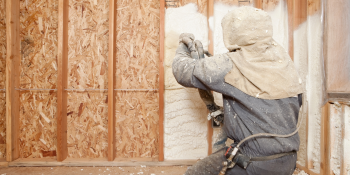Q&A Forums
exaggerating R-value of foam Post New Topic | Post Reply
| Author | Comments |
|---|---|
|
Ryan Rhoads
Posted: Mar 04, 2007 10:23 PM
|
exaggerating R-value of foam
First of all I apologize to everyone about my not being on for so long it was a hectic year last year. I have a couple of competitors that are exaggerating the R-value's of 1/2lb. foam. I have lost two jobs for sure and maybe more since I have not gotten a job in a couple of months due to this. One job had 2x4 walls and my bid was $5000 more than the other guy. I had bid the job using a 2lb. closed cell foam and after re figuring the job with 1/2 lb. foam the difference was pretty close to $5000. On the other job I was got to look at the other persons bid and it stated that he would install 3 1/2 inches of soft foam (I assume that it means 1/2lb.) to provide an R-26. What is everyones thoughts and what should I do? |
|
Thomas Kasper
Posted: Mar 04, 2007 11:22 PM
|
I tell my potential customers to make sure they compare apples to apples. I always carry a sample of cc and oc. and let them be aware of differences. It helps, to a point. |
|
Dave Strnad
Posted: Mar 05, 2007 01:16 PM
|
I have experienced similar fools. Locally one guy is bidding 6" of Open cell Specifically the one that starts with I, and he is calling it an R-38. I know of two jobs where this was done and the customers are having major icing problems. It can be difficult. I bid everything with open cell and closed cell, it helps people to see on paper the price difference so when they are getting bids they are more aware of the difference. Here they are using the term effective R-value they put it right on the bids. It seems like a lot of people have a hard time grasping the difference between the two so I spend a lot of time on it even if they don't specifically ask. I now carry my competitors product info sheets with me as reference. This fall I became very frustrated when I lost 3 jobs and the customer's said I was $5000-$6000 high. When I asked if they had open or closed cell installed and they said niether the frustration grew even more. |
|
philip mullins
Posted: Mar 05, 2007 03:10 PM
|
i hate cut throats. i am new to the spf game but i have operated magnolia deck and fence for many years. and i was one of 5 fence builders in the county. since katrina every joe with a hammer is a fence builder now. these guys started out charging twice what i charge. and now that things have slowed down, they are doing it for half my price. the one thing that has kept me going is the fact that i just do a better job. word of mouth goes a long way. i may not be the best deck builder out there. but i do my best on every job. go the extra mile for all your customers and word will get out. these other guys keep thier prices low by not paying taxes, insurance,or any of the overhead that honest buisness have to. or selling an inferior product. and because of that, they wont last. remind your prospects that ANY contractor can only sell 3 things. price, quality, and time. but, they can only have 2. anyone claiming to sell all 3 are lying. or will be in the poor house real fast. something else that us local guys have found that works real well on these big out of town contractors that have taken most of our work by using cheap mexican labor... a good ole fashioned louisville slugger. a little primitive but, effective none the less. |
|
Ryan Rhoads
Posted: Mar 05, 2007 05:43 PM
|
DaveS; could you elaborate on the icing problems that they have been having. Also has anyone had in problems where just 3.5" of 1/2 lb. foam has been installed in a wall where code requires an R-19. Does this even work. I have told my clients that I would spray the same thickness as they are and for a competitive price, but I don't want them calling me back in a year complaining of problems or high utility bills. |
|
Dave Strnad
Posted: Mar 05, 2007 06:10 PM
|
The icing problems that I am refering to is that the exterior of the roof is getting warm thus melting snow then it feezes on the overhang creating a dam of ice. The water then builds up enough that it will seep up under the shingles and then leaks inside though nail holes or where ever it can find a way in. This problem is usually associated with poorly vented roofs and is a concern of people when they go with a ventless SPF aplication. I have sprayed several roofs this way with no problems but you need to apply enough SPF to keep the freeze thaw point within the foam. THe chart in the R-myth booklet explains this well. With four inches of closed cell the surface temps will be near the indoor/outdoor temps and should not cause any problems. |
|
Posted: Mar 05, 2007 09:39 PM
|
I have found that the icing is caused by the lack of or inferior insulation in the roof. The warm air within the house contacts the underside of the roof deck and warms the snow causing it to melt and build up along the eaves. The ice will works its way under the shingles and eventually leak into the house. The closed cell eliminates the possibility for the warm air to ever reach the roof deck and therefore the melting from below is reduced/eliminated. Tim Granite State Spray Foam Co. |
|
Richard Russell
Posted: Mar 06, 2007 07:26 AM
|
I suppose it should be noted that the snow layer itself is an insulation of sorts, being full of air. Sled dogs bury themselves in it when sleeping outside. Heat that escapes through the roofing to some extent leaks out through the snow by conduction, just as it does through the insulation under the deck. The more heat that must pass through the assembly of roof and snow, the higher the temperature difference between roof deck and air above the snow. That means a higher temperature on the roof side of the snow, and if that reaches the melting point then you have melting as the place for the excess heat to go. There are two ways to avoid this. One is to have a vented roof, with a layer of cold air rising up just under the roof deck to keep it cold. With an unvented roof, you simply need sufficient total R value below the roof deck, relative to the R value of the snow covering, so that in the temperature profile across insulation and snow the melting point occurs within the insulation and everything above that point is colder. This keeps the overall heat loss down to a point where the reduced temperature difference across just the snow layer is enough to pass that heat load. Overall translation: more R under the roof, and required R value divided by the inches of space tells you whether that insulation must be closed cell. Going a bit farther, there also is the matter of thermal bridging of the rafters. Some time after a snow begins to melt, many houses will reveal just where the rafters are at a glance from the street by the melt lines. You can't reduce the heat lost collectively through those rafters, unless you add a layer of insulation at the edge of each rafter or over the deck. Otherwise that means the need for that much less heat loss through the insulated part to compensate. A 2x6 rafter, at a wood R value of, say, 1 per inch gives you a total R of around 6, including the roof deck. If you add a 1 inch layer of insulation on either end, that 1.5" inch wide rafter now has an R value of about 12 and the heat loss is cut in half. Insulation doesn't eliminate thermal bridging - it reduces it. |
|
Gerry Wagoner
Posted: Mar 06, 2007 11:15 AM
|
Each manufacturer is obligated by disclosure law to provide a technical data sheet that states the R-value of the product. There is an ASTM test that defines all insulations. A simple way to flush out dishonest contractor/manufacturers is to request a copy of this data sheet on their product. They are obligated by law to produce that. olger |




























